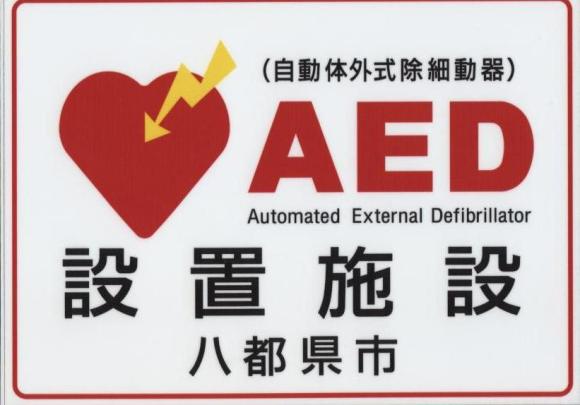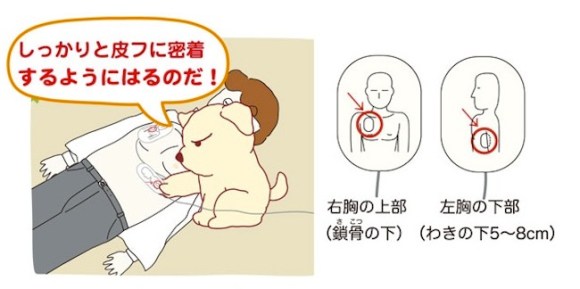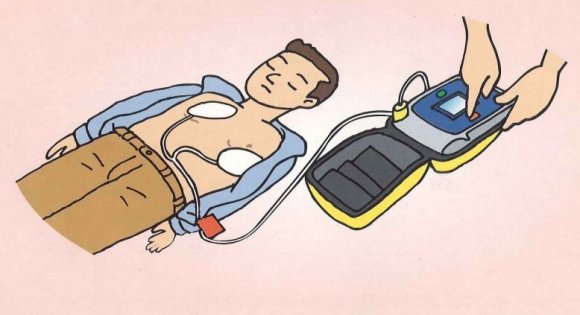
A man in Japan says he was questioned by police and branded a “pervert” after providing emergency medical assistance to a stranger. The man was attending to a woman who had been involved in a traffic accident when he believes someone who saw him cutting through the woman’s clothes to apply a defibrillator to her bare chest called the police and reported him for behaving inappropriately.
An Automated External Defibrillator (AED) analyses the rhythm of the heart and, if necessary, delivers an electrical shock to help it return to normal. AEDs are provided in public places and are designed to be operated by members of the public, even those with no medical background. The man is now calling for better understanding of the correct use of AEDs.
In a series of posts on Twitter earlier this month, the unnamed Japanese man described the incident, which he says occurred three years ago. He happened upon the scene of a traffic accident in which the driver was not seriously injured, but a female passenger was unconscious and he could not detect a pulse. The man began to administer artificial respiration and CPR to the woman, and contacted the emergency services. After an AED was procured from a nearby convenience store, the man began to cut through the woman’s clothes in order to administer it.
An AED, which applies an electric shock to a patient suffering cardiac arrest, requires direct contact between the pads and the skin. Any clothing which is in the way must be removed.
However, when the man started to use the scissors, which were included in the AED’s box, to cut through the woman’s clothes, the driver of the vehicle told him to stop, asking what he was doing and calling him “hentai” (pervert). At this time, he believes, the driver of the car contacted the police to report him as a “chikan” (sexual molester).
▼ Puppies, however, are ok to use the machinery apparently.
After the injured parties had been taken to hospital, the man who had administered the AED gave his account of the incident to police. He was then handed over to a separate police authority, who questioned him about the report they had received that he was acting inappropriately at the scene of the accident. Once the man explained that he had been cutting through the woman’s clothes in order to use the AED, he was not questioned any further.
The man was later informed that – thanks to his bravery and quick-thinking, not to mention correct use of the AED – the woman had survived. He also reported that he was offered a certificate of appreciation, which he declined. The Twitter user ends his story with this comment:
皆さん、AEDは肌に密着させるものです。強い電気が流れるのでブラジャーのワイヤーも大変危険です。知っててください。
“An AED is supposed to be applied directly to the skin. Because the electric current it produces is strong, the underwire of a bra could prove extremely dangerous [if not removed before using]. Please remember this.”
In Japan, as in other countries, AEDs are provided in public spaces such as shopping centres, schools and sports facilities. They are designed to be operated by members of the public who may not have received training, and their use is covered in first aid courses.
Time is of the essence in the event of a sudden cardiac arrest: after only three to five minutes, the patient can start to suffer irreversible brain damage. The Red Cross states that for each minute defibrillation is delayed, the chance of survival drops by 10 percent. Increased public awareness about where to find AEDs and how to use them, as well as increased provision of the devices, are therefore vital to reducing deaths from cardiac arrest.
It seems like this incident had a happy ending, but it seems that if the person who called the police – or indeed the police officers themselves – had known that it was necessary to remove clothing to use an AED, they wouldn’t have had to waste time interviewing someone who was acting entirely appropriately.
Sources: Huffington Post Japan, News Matomemorii, Twitter (1, 2, 3, 4, 5, 6, 7, 8), Red Cross, AED Life, Japan Heart Foundation
Images: Kyoto City Fire Department, Japan Heart Foundation, Chiba Social Welfare & Public Health Department
Featured image: Sanwa




 Pervert hunter arrested by Tokyo police for less-than-pure intentions
Pervert hunter arrested by Tokyo police for less-than-pure intentions Osaka man arrested after sharing futon with dead girlfriend’s body for five nights
Osaka man arrested after sharing futon with dead girlfriend’s body for five nights Man hangs himself outside of Japan’s busiest train station
Man hangs himself outside of Japan’s busiest train station Outrage sparked: Tokyo truck driver abandons body of suicide victim, claims the body was a “doll”
Outrage sparked: Tokyo truck driver abandons body of suicide victim, claims the body was a “doll” Groper arrested in Japan insists he did not grab both breasts, but just one
Groper arrested in Japan insists he did not grab both breasts, but just one Foreigner’s request for help in Tokyo makes us sad for the state of society
Foreigner’s request for help in Tokyo makes us sad for the state of society Japanese-style accommodation at the new Premium Dormy Inn hotel in Asakusa will blow your mind
Japanese-style accommodation at the new Premium Dormy Inn hotel in Asakusa will blow your mind Mikado Coffee is a 76-year-old coffee chain with a major celebrity connection
Mikado Coffee is a 76-year-old coffee chain with a major celebrity connection Seaside scenery, history, and so many desserts on Yokohama’s Akai Kutsu【Japan Loop Buses】
Seaside scenery, history, and so many desserts on Yokohama’s Akai Kutsu【Japan Loop Buses】 11 different ways to say “father” in Japanese
11 different ways to say “father” in Japanese Is the new Shinkansen Train Desk ticket worth it?
Is the new Shinkansen Train Desk ticket worth it? Do Hi-Chew-flavor Hi-Chews have a reason to exist?【Taste test】
Do Hi-Chew-flavor Hi-Chews have a reason to exist?【Taste test】 Japan’s summertime towelket pillowcases are even better with the addition of Ghibli stars【Photos】
Japan’s summertime towelket pillowcases are even better with the addition of Ghibli stars【Photos】 Cappuccino Ramen becomes super popular in Japan, but is it worth the hype?
Cappuccino Ramen becomes super popular in Japan, but is it worth the hype? Fried sandwiches arrive in Tokyo, become hot topic on social media
Fried sandwiches arrive in Tokyo, become hot topic on social media McDonald’s new Happy Meals offer up cute and practical Sanrio lifestyle goods
McDonald’s new Happy Meals offer up cute and practical Sanrio lifestyle goods Japanese ramen restaurants under pressure from new yen banknotes
Japanese ramen restaurants under pressure from new yen banknotes French Fries Bread in Tokyo’s Shibuya becomes a hit on social media
French Fries Bread in Tokyo’s Shibuya becomes a hit on social media Red light district sushi restaurant in Tokyo shows us just how wrong we were about it
Red light district sushi restaurant in Tokyo shows us just how wrong we were about it New private rooms on Tokaido Shinkansen change the way we travel from Tokyo to Kyoto
New private rooms on Tokaido Shinkansen change the way we travel from Tokyo to Kyoto Tokyo Tsukiji fish market site to be redeveloped with 50,000-seat stadium, hotel, shopping center
Tokyo Tsukiji fish market site to be redeveloped with 50,000-seat stadium, hotel, shopping center Japanese city loses residents’ personal data, which was on paper being transported on a windy day
Japanese city loses residents’ personal data, which was on paper being transported on a windy day Beautiful Ghibli sealing wax kits let you create accessories and elegant letter decorations【Pics】
Beautiful Ghibli sealing wax kits let you create accessories and elegant letter decorations【Pics】 Secret Kitchen bento serves Japanese flowers, birds, wind and moon in a box, but is it worth it?
Secret Kitchen bento serves Japanese flowers, birds, wind and moon in a box, but is it worth it? New definition of “Japanese whiskey” goes into effect to prevent fakes from fooling overseas buyers
New definition of “Japanese whiskey” goes into effect to prevent fakes from fooling overseas buyers Our Japanese reporter visits Costco in the U.S., finds super American and very Japanese things
Our Japanese reporter visits Costco in the U.S., finds super American and very Japanese things Studio Ghibli releases Kiki’s Delivery Service chocolate cake pouches in Japan
Studio Ghibli releases Kiki’s Delivery Service chocolate cake pouches in Japan All-you-can-drink Starbucks and amazing views part of Tokyo’s new 170 meter-high sky lounge
All-you-can-drink Starbucks and amazing views part of Tokyo’s new 170 meter-high sky lounge More foreign tourists than ever before in history visited Japan last month
More foreign tourists than ever before in history visited Japan last month New Pokémon cakes let you eat your way through Pikachu and all the Eevee evolutions
New Pokémon cakes let you eat your way through Pikachu and all the Eevee evolutions Disney princesses get official manga makeovers for Manga Princess Cafe opening in Tokyo
Disney princesses get official manga makeovers for Manga Princess Cafe opening in Tokyo Sales of Japan’s most convenient train ticket/shopping payment cards suspended indefinitely
Sales of Japan’s most convenient train ticket/shopping payment cards suspended indefinitely Sold-out Studio Ghibli desktop humidifiers are back so Totoro can help you through the dry season
Sold-out Studio Ghibli desktop humidifiers are back so Totoro can help you through the dry season Japanese government to make first change to romanization spelling rules since the 1950s
Japanese government to make first change to romanization spelling rules since the 1950s Ghibli founders Toshio Suzuki and Hayao Miyazaki contribute to Japanese whisky Totoro label design
Ghibli founders Toshio Suzuki and Hayao Miyazaki contribute to Japanese whisky Totoro label design Doraemon found buried at sea as scene from 1993 anime becomes real life【Photos】
Doraemon found buried at sea as scene from 1993 anime becomes real life【Photos】 Tokyo’s most famous Starbucks is closed
Tokyo’s most famous Starbucks is closed One Piece characters’ nationalities revealed, but fans have mixed opinions
One Piece characters’ nationalities revealed, but fans have mixed opinions We asked a Uniqlo employee what four things we should buy and their suggestions didn’t disappoint
We asked a Uniqlo employee what four things we should buy and their suggestions didn’t disappoint Elderly motorists in Japan given option to “graduate from driving” to prevent accidents
Elderly motorists in Japan given option to “graduate from driving” to prevent accidents Japanese police question man for “not looking good in a suit,” turns out he robbed an old lady
Japanese police question man for “not looking good in a suit,” turns out he robbed an old lady “Nine grooming steps guys need to do to be popular with women in Japan” sparks online debate
“Nine grooming steps guys need to do to be popular with women in Japan” sparks online debate Man in Japan breaks through his own apartment floor to attack woman’s TV
Man in Japan breaks through his own apartment floor to attack woman’s TV Japanese bus driver chases down groper who targeted 18-year-old girl on his vehicle
Japanese bus driver chases down groper who targeted 18-year-old girl on his vehicle Japanese woman asks for advice on how to deal with smell of son’s corpse, gets arrested
Japanese woman asks for advice on how to deal with smell of son’s corpse, gets arrested Oita woman loses lawsuit and pays damages without ever knowing she’d been sued
Oita woman loses lawsuit and pays damages without ever knowing she’d been sued Serial foot licker apprehended in Kyoto after 30-minute lick-attack
Serial foot licker apprehended in Kyoto after 30-minute lick-attack Defibrillator toys from Japanese capsule machines are so realistic they might save a life
Defibrillator toys from Japanese capsule machines are so realistic they might save a life Twitter users band together to help find road-rage attacker in Osaka 【Video】
Twitter users band together to help find road-rage attacker in Osaka 【Video】 Bus driver’s kind service towards blind passenger wins praise from Taiwanese netizens
Bus driver’s kind service towards blind passenger wins praise from Taiwanese netizens Traffic accident scammer caught on CCTV in China, ends up having to pay fine himself 【Video】
Traffic accident scammer caught on CCTV in China, ends up having to pay fine himself 【Video】 Ambulance in China dumps patient after realizing he was already dead to help at other incident
Ambulance in China dumps patient after realizing he was already dead to help at other incident Osaka police sergeant arrested for putting smartphone between woman’s legs on train
Osaka police sergeant arrested for putting smartphone between woman’s legs on train “Conbini warp” an increasing traffic problem for businesses and authorities across Japan
“Conbini warp” an increasing traffic problem for businesses and authorities across Japan Japanese teen calls cops on man she thinks is holding a knife, turns out he just has old tech
Japanese teen calls cops on man she thinks is holding a knife, turns out he just has old tech
Leave a Reply